July 1, 2010
Earlier this month local birders were thrilled to hear about the sighting of a California Clapper Rail in San Francisco. This chicken sized brown rail, with a chestnut colored breast, is an endangered subspecies of the Clapper Rail that, prior to this month, had only been seen twice in the City in the past 30 years.
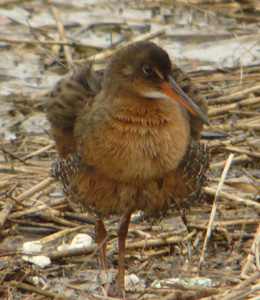 Clapper Rails like to hide in marsh vegetation, rarely fly, and are hard to see, except at high tide, when they are forced out of their camouflaged hiding spots. They are very vocal birds, with a loud rattling call. Nesting pairs of Clapper Rails harmonize their calls, so that two birds calling often sound like just one bird. Loss of habitat, hunting and predation had reduced the population of the California Clapper Rail to an estimated 240 birds in 1992. Fortunately conservation measures have allowed the population to expand, and they now number more than 1,000, almost exclusively in the San Francisco Bay Area.
Clapper Rails like to hide in marsh vegetation, rarely fly, and are hard to see, except at high tide, when they are forced out of their camouflaged hiding spots. They are very vocal birds, with a loud rattling call. Nesting pairs of Clapper Rails harmonize their calls, so that two birds calling often sound like just one bird. Loss of habitat, hunting and predation had reduced the population of the California Clapper Rail to an estimated 240 birds in 1992. Fortunately conservation measures have allowed the population to expand, and they now number more than 1,000, almost exclusively in the San Francisco Bay Area.
The Clapper Rail sighting is the latest enhancement to the riches of Heron’s Head Park, a 25 acre park in the southeast sector of the City. This shoreline park, officially created in 1999, is a San Francisco hotspot for a number of birds, particularly shorebirds and ducks.
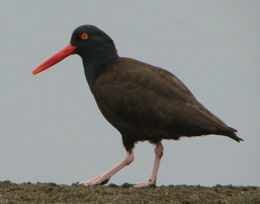
In the summer, this small park now houses nesting shorebirds, including American Black Oystercatchers, American Avocets and Black Necked Stilts. The American Black Oystercatcher, found only along the Pacific Coast of North America, is an all black bird, with a large, bright red bill and yellow eyes.
Black Oystercatchers are only found on rocky shores, and can usually be spotted around the Cliff House as well as at Heron’s Head Park. This summer visitors to Heron’s Head have seen Oystercatchers feeding a chick on the pier. Although their diet focuses on shellfish, mussels and marine worms, Black Oystercatchers can’t swim, but chicks have been known to dive under water to escape predators. Black Oystercatchers are relatively long lived for birds, with a lifespan that often exceeds 15 years.
On my latest visit to Heron’s Head Park, a couple of weeks ago, I noticed American Avocets reacting strongly to anyone walking along the main path, even though the birds were not all that close to the path. They were defending their nesting site. Avocets lay their eggs on bare open soil near water, and their only nest building efforts take place if water levels rise. Then they will use sticks, bones, weeds and feathers to keep the eggs above water.
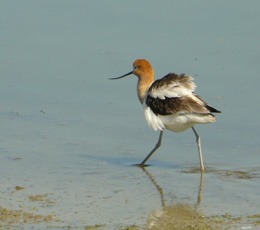 American avocets have a bold black and white pattern on their back and wings, and in summer sport a cinnamon neck and head (which turns gray in the winter). Chicks leave the nest within 24 hours of hatching. A day old chick can walk, swim and even dive to escape predators!
American avocets have a bold black and white pattern on their back and wings, and in summer sport a cinnamon neck and head (which turns gray in the winter). Chicks leave the nest within 24 hours of hatching. A day old chick can walk, swim and even dive to escape predators!
Another recent first for Heron’s Head Park was the successful nesting of Black Necked Stilts, a bird that historically nested in the City, but hasn’t done so for decades. Last summer a pair tried nesting at the park, but the nest failed. This summer, a pair is raising four chicks. Although chicks leave the nest within two hours, they are cared for by their parents for about a month before heading out on their own.
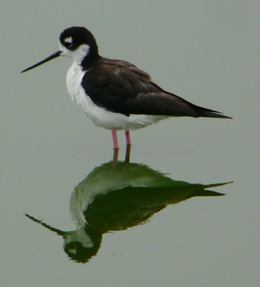 Black Necked Stilts are one of my favorite shorebirds. They are striking waders, with bright black and white plumage, and long pink legs. They have the second longest legs in proportion to their body of any bird, exceeded only by flamingos. Their call is unmistakable. Black Necked Stilts have half webbed feet, which allow them to swim, although they rarely do.
Black Necked Stilts are one of my favorite shorebirds. They are striking waders, with bright black and white plumage, and long pink legs. They have the second longest legs in proportion to their body of any bird, exceeded only by flamingos. Their call is unmistakable. Black Necked Stilts have half webbed feet, which allow them to swim, although they rarely do.
For some, summer starts in July. But for a number of species of birds, July marks the end of summer and the beginning of a migration to a warmer climate. Starting this month, the nesting shorebirds at Heron’s Head Park are joined by migratory shorebirds, arriving here in preparation for the winter.
On my last visit to the park, a number of migratory birds had already arrived. A group of Willets performed acrobatics around the shoreline. If you see this bird standing on the edge of a body of water in the winter, it is rather nondescript – essentially an all gray bird. However, as soon as it flies, it shows a bright black and white wing pattern. And, in the summer, Willets sport a spotted brown plumage. In addition to the Willets, six other species of shorebirds have already arrived at Heron’s Head and they will soon be joined by up to another dozen species.
In addition to shorebirds, Heron’s Head Park is a haven for wintering ducks, with a number of species arriving in the fall and staying until spring. A few hang around all summer. Most notably, a male Harlequin Duck has been spotted all year – I saw him at the end of the pier earlier this month in the company of a Surf Scoter (who theoretically should also have left for Alaska or northern Canada months ago).
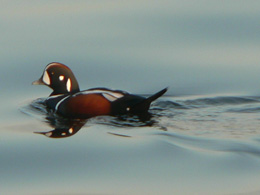 In late summer, graceful terns also show up at the park. Caspian (the largest tern in the world) and Elegant Terns are post-breeding migrants, which means they migrate after they nest, away from their breeding grounds, where they feed for a few months before heading to wintering grounds. Elegant Terns nest in southern California and Mexico, and actually migrate north after nesting – going as far north as British Columbia in late summer and fall. A third species of tern – the Forster’s Tern - can also be found at Heron’s Head.
In late summer, graceful terns also show up at the park. Caspian (the largest tern in the world) and Elegant Terns are post-breeding migrants, which means they migrate after they nest, away from their breeding grounds, where they feed for a few months before heading to wintering grounds. Elegant Terns nest in southern California and Mexico, and actually migrate north after nesting – going as far north as British Columbia in late summer and fall. A third species of tern – the Forster’s Tern - can also be found at Heron’s Head.
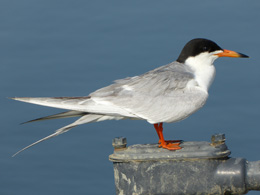 The terns found here are white with black heads, with orange or red bills. They circle a body of water, hover above the water and then dive for fish like a pelican (terns are more graceful, however).
The terns found here are white with black heads, with orange or red bills. They circle a body of water, hover above the water and then dive for fish like a pelican (terns are more graceful, however).
The bird list for Heron’s Head Park now approaches 100 or more species, and the park is one of a number of great birding spots in the Southeast part of San Francisco. Despite all the pollution and environmental burdens that have been inflicted on the Bayview, it’s clear that with effort and stewardship, wildlife refuges can still be maintained and supported. The park now has an EcoCenter, supported and staffed by Literacy for Environmental Justice, providing an introduction to this amazing place for many residents.
All pictures were taken by David Assmann, Deputy Director of the San Francisco Department of the Environment. Do not reproduce pictures without permission.